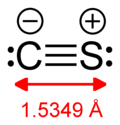Carbon monosulfide

| |
| Names | |
|---|---|
| IUPAC name
carbon monosulfide
| |
| Other names
carbon(II) sulfide
| |
| Identifiers | |
CompTox Dashboard (EPA)
|
|
| Properties | |
| CS | |
| Molar mass | 44.07 g·mol−1 |
| Appearance | reddish crystalline powder |
| insoluble | |
Except where otherwise noted, data are given for materials in their standard state (at 25 °C [77 °F], 100 kPa).
| |
Carbon monosulfide is a chemical compound with the formula CS. This diatomic molecule is the sulfur analogue of carbon monoxide, and is unstable as a solid or a liquid, but it has been observed as a gas both in the laboratory and in the interstellar medium.[1] The molecule resembles carbon monoxide with a strong bond between carbon and sulfur. The molecule is not intrinsically unstable, but it tends to polymerize. This tendency reflects the greater stability of C-S single bonds.
Polymers with the formula (CS)n have been reported.[2] Also, CS has been observed as a ligand in certain transition metals.
References
- ^ Wilson, R. W.; Penzias, A. A.; Wannier, P. G.; Linke, R. A. "Isotopic abundances in interstellar carbon monosulfide" Astrophysical Journal, 1976, volume 204, L135-L137.
- ^ Chou, J.-H. and Rauchfuss, T. B., "Solvatothermal Routes to Poly(Carbon Monosulfide)s Using Kinetically Stabilized Precursors", Journal of the American Chemical Society, 1997, volume 119, 4537-4538. DOI: 10.1021/ja970042w
